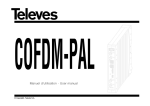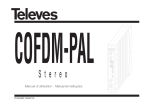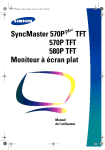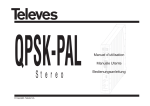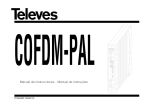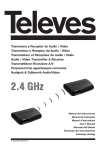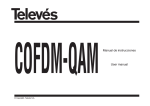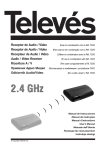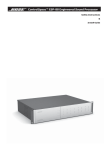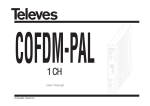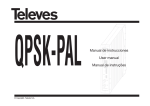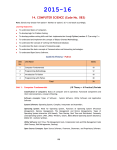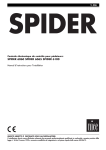Download Manuel d`utilisation - User manual - Online
Transcript
COFDM-PAL
Manuel d’utilisation - User manual
© Copyright, Televés S.A.
Manuel d’utilisation
COFDM-PAL
1.
Caractéristiques techniques . . . . . . . . . . . . . . . . . . . . . . . . . . . . . . . . . . . . . . . . . . . . . . . . . . . . . . . . . . . . . . . . . . . . . . .
4
2.
Description des références . . . . . . . . . . . . . . . . . . . . . . . . . . . . . . . . . . . . . . . . . . . . . . . . . . . . . . . . . . . . . . . . . . . . . . . .
5
Montage . . . . . . . . . . . . . . . . . . . . . . . . . . . . . . . . . . . . . . . . . . . . . . . . . . . . . . . . . . . . . . . . . . . . . . . . . . . . . . . . . . . . . .
6
3.1 Montage sur rail
6
3.
.............................................................................
3.2 Montage sur Rack 19”
4.
........................................................................
7
Description des éléments . . . . . . . . . . . . . . . . . . . . . . . . . . . . . . . . . . . . . . . . . . . . . . . . . . . . . . . . . . . . . . . . . . . . . . . . .
8
4.1. COFDM-PAL . . . . . . . . . . . . . . . . . . . . . . . . . . . . . . . . . . . . . . . . . . . . . . . . . . . . . . . . . . . . . . . . . . . . . . . . . . . . . . .
8
4.2. Module d’alimentation . . . . . . . . . . . . . . . . . . . . . . . . . . . . . . . . . . . . . . . . . . . . . . . . . . . . . . . . . . . . . . . . . . . . . . . .
9
4.3. Centrale d’amplification
......................................................................
10
4.4. Programmateur PCT 3.0 . . . . . . . . . . . . . . . . . . . . . . . . . . . . . . . . . . . . . . . . . . . . . . . . . . . . . . . . . . . . . . . . . . . . . .
11
4.5. Programmateur PCT 4.0 . . . . . . . . . . . . . . . . . . . . . . . . . . . . . . . . . . . . . . . . . . . . . . . . . . . . . . . . . . . . . . . . . . . . . .
12
5.
Facon de procede avec le programmateur PCT 3.0 . . . . . . . . . . . . . . . . . . . . . . . . . . . . . . . . . . . . . . . . . . . . . . . . . . . . .
13
6.
Facon de procede avec le programmateur PCT 4.0 . . . . . . . . . . . . . . . . . . . . . . . . . . . . . . . . . . . . . . . . . . . . . . . . . . . . .
19
7.
Contrôle du dispositif . . . . . . . . . . . . . . . . . . . . . . . . . . . . . . . . . . . . . . . . . . . . . . . . . . . . . . . . . . . . . . . . . . . . . . . . . . . .
24
8.
Exemples d’applications . . . . . . . . . . . . . . . . . . . . . . . . . . . . . . . . . . . . . . . . . . . . . . . . . . . . . . . . . . . . . . . . . . . . . . . . . .
25
9.
Normes pour montage en rack . . . . . . . . . . . . . . . . . . . . . . . . . . . . . . . . . . . . . . . . . . . . . . . . . . . . . . . . . . . . . . . . . . . . .
27
10. Normes pour montage en coffret . . . . . . . . . . . . . . . . . . . . . . . . . . . . . . . . . . . . . . . . . . . . . . . . . . . . . . . . . . . . . . . . . . .
29
A.
59
Tables des canaux . . . . . . . . . . . . . . . . . . . . . . . . . . . . . . . . . . . . . . . . . . . . . . . . . . . . . . . . . . . . . . . . . . . . . . . . . . . . . .
3
FRANCAIS
SOMMAIRE
Manuel d’utilisation
COFDM-PAL
1.- CARACTERISTIQUES TECHNIQUES
1.1.- COFDM-PAL
ref. 5054
Démodulateur
COFDM
Pertes de passage entrée: < 1.2 dB
Fréquence d’entrée:
174-230 / 474-858 MHz
o tables de canaux
Pas de fréquence:
1 MHz
Marge d’accrochage:
± 3 MHz
Niveau d’entrée:
49 à 89 dBµV (-60 à -20 dBm)
(8K, 64 QAM, FEC 2/3)
Filtre SAW:
Séléccionnable 7 - 8 MHz
ROE d’entrée (75 ohm):
Rapport signal/bruit:
FFT:
Constellation:
Intervalle de garde:
Taux Viterbi:
Vitesse de symbole max:
Standard de transmission:
> 12 dB (46 - 862 MHz)
> 20 dB
2K, 8K
QPSK, 16 QAM, 64 QAM
1/4, 1/8, 1/16, 1/32
1/2, 2/3, 3/4, 5/6, 7/8
31.67 Msymbole/sec
ETS300744
Décodification
MPEG-2
Format d’entrée:
Décodification:
Vitesse d’entrée TS:
TS MPEG-2/DVB
MP@ML
Max. 60 Mbits/sec
Vitesse video:
Résolution video:
Sortie video
1.5 à 15 Mbits/sec
Max. 720 x 576
Vídeo composite PAL
Fréquence de sortie:
46 - 862 MHz
o tables de canaux
250 KHz
80 dBµV ±5 dB (séléc. SW)
Marge de régulation:
ROE de sortie (75 ohm):
Pertes de passage:
Niveau réponse en bande:
15 dB
10 dB min. 14 dB tip.
< 1.5 dB (46-862 MHz)
55 dBc min. 60 tip.
Sortie
RF
Général
Pas de fréquence:
Niveau de sortie max:
Alim pré-amplificateur:
Consommations:
Séléccionnable 0 / 12 / 24V
5V : 1,2 A tip
15V : 0,4 A tip.
(< 50 mA)
Les caractéristiques techniques décrites sont définies pour une température ambiante maximum de 40°C
4
Manuel d’utilisation
COFDM-PAL
Centrale
Marge de fréquence:
Gain:
Marge de régulation:
Tension de sortie (60 dB):
47 ... 862 MHz
45 ± 2 dB
20 dB
105 dBµV (42 CH CENELEC)
Connecteur:
Alimentation:
Consommation à 15 V:
Prise test:
“F”
15 V
800 mA
-30 dB
230 ± 15 % V~
5, 15, 18, 24V
Courant max
correspodant:
24V
18V
15V
5V
1 . 3.- Caracteristiques techniques ref. 5029
Module
d’alimentation
Tension d’entrée:
Tensions de sortie:
(0,55 A)
(0,8 A)
(4,2 A)(1)
(6,6 A)
(1) Si les tensions 24V et/ou 18V sont utilisés, vous devrez enlever leur puissance consommée à la puissance de 15V.
2.- DESCRIPTION DES REFERENCES
Ref. 5054 .... COFDM-PAL
(174 - 230 / 474 - 858 MHz)
Ref. 7234 .... Programmateur universel
Ref. 5075 .... Amplificateur
(47 - 862 MHz)
Ref. 5071 .... Support universel 10 mod + Alim.
Ref. 5029 .... Alimentation
(230 V~ ± 15 % - 50/60 Hz)
(24 V
- 0,55 A)
(18 V
- 0,8 A)
(15 V
- 4,2 A)(1)
(5 V
- 6,6 A)
Ref. 5239 .... Support T40/T50 12 mod + Alim.
Ref. 8250 .... Subrak 19’
Ref. 5301 .... Support subrack 19”
Ref. 5072 .... Coffret universel
Ref. 4061 .... Charge “F” 75 ohm avec blocage DC
Ref. 4058 .... Charge “F” 75 ohm sans blocage DC
Ref. 5073 .... Cache format T05
Ref. 5301
Ref. 5072
Ref. 8250
5
FRANCAIS
1 . 2.- Caractéristique technique amplificateur ref. 5075
Manuel d’utilisation
COFDM-PAL
3 .- MONTAGE
3.1.- Montage sur rail
a
a
5054
5075
5029
CLAC!
COFDM-PAL
COFDM-PAL
COFDM-PAL
A/V
A/V
COFDM-PAL
A/V
A/V
PRGM
5071
5239
1
CTRL
CTRL
CTRL
CTRL
PWR
PWR
PWR
PWR
PRGM
PRGM
PRGM
PWR
PWR
PWR
TEST
(-30dB)
2
PC
105366
T4
.0
A
UN
IVE
B
RS
C
AL
4061
7234
6
Manuel d’utilisation
COFDM-PAL
CLAC!
COFDM-PAL
COFDM-PAL
COFDM-PAL
A/V
A/V
COFDM-PAL
A/V
A/V
TEST
(-30dB)
PRGM
7
CTRL
CTRL
5073
CTRL
PWR
PWR
PWR
PWR
PRGM
PRGM
PRGM
PWR
CTRL
PWR
PWR
5301
FRANCAIS
3.2.- Montage sous rack 19”
Manuel d’utilisation
COFDM-PAL
4. - DESCRIPTION DES ELEMENTS
4.1.- COFDM-PAL
1
COFDM-PAL
2
CTRL
PWR
PRGM
A/V
5
3
7
9
4
6
1.- Entrée BIII / UHF + DC
2.- Sortie BIII / UHF
3.- Entrée RF
4.- Sortie RF
5.- Sortie A/V (1)
6.- connecteur programmateur / PC
7.- Entrée alimentation module
8.- LED de fonctionnement
9.- Connecteur BUS de contrôle
8
Pour cela, le module réalise la démodulation
COFDM du canal d’entrée (multiplexe), en
COFDM-PAL
Référence du produit
obtenant un signal MPEG-2 TS (paquet de
transport MPEG-2), pour obtenir la modulation précédente, selon la norme, des signaux audio/video du programme sélectionné
dans chaque canal ou fréquence entre 46 et
862MHz.
Il est également possible de controler l’unité
à travers un PC comme expliqué dans le
paragraphe 6.
8
-1 -2 -3 -4 -5 -6 -7 -8 -
Indiquez le canal
d’entrée programmé
Indiquez le canal de
sortie programmé
Le transmodulateur COFDM remodule un
canal de TV ou radio (sélectionné par l’utilisateur) à partir d’un canal existant sous la
forme d’un multiplex de télévision numérique terreste (modulation COFDM et largeur
de bande approximative de 7/8 MHz) en un
canal VHF / UHF (modulation en standard
PAL et largeur de bande 7/8 MHz).
(1)
Masse
Sortie video
Sortie audio “R”
Sortie audio “L”
5054
Ch
Indiquez la direction du
dispositif pour le contrôle
à distance (001 ... 254)
Le transmodulateur COFDM-PAL dispose
d’une entrée et sortie BIII et UHF sur les
connecteurs “F” supérieurs permettant le
passage du signal vers d’autres modules.
Il dispose également de connecteurs
d’entrée et de sortie RF, afin de coupler les
canaux de sortie avant amplification.
Manuel d’utilisation
COFDM-PAL
4.2.- Module d’alimentation
(1)
A/V
(1)
CTRL
+ 5V
+ 24V
GND
N/C
LED de fonctionnement
NOTE:
L’alimentation peut alimenter un maximum de 5 modules COFDM-PAL.
PWR
PWR
Connecteur d’alimentation des
modules (1)
Entrée réseau
230V~
9
FRANCAIS
PWR
+ 15V
PWR
PRGM
+ 18V
Manuel d’utilisation
COFDM-PAL
4.3.- Centrale d’amplification
Ce module réalise l’amplification des
canaux générés dans les transmodulateurs COFDM-Pal, sur la bande de fréquence 47 à 862 MHz
Il dispose de deux connecteurs d’entrée
de signal, afin de permettre le couplage
de canaux venant d’un autre système.
Si une seule entrée est utilisée, il est
recommandé de boucher l’entrée non
utilisée avec une charge 75 ohm, ref
4061.
1
2
TEST
(-30dB)
PWR
5
7
3
4
234632
1.- Sortie RF
2.- Sortie Test
3.- Entrée RF
4.- Entrée RF
5.- Entrée d’alimentation des modules
6.- Atténuateur
7.- LED de fonctionnement
10
6
La centrale dispose également d’un
connecteur de sortie et d’une prise test
(-30dB) situés sur la partie supérieure
de la façade avant.
L’alimentation de l’amplificateur se fait
en 15V, à travers une nappe identique à
celle utilisée pour l’alimentation des
autres modules du système.
Manuel d’utilisation
COFDM-PAL
4.4. - Programmateur PCT 3.0
PCT 3.0
UNIVER
SAL
CO
COFDM-PAL
FDM
-PA
L
50
54
Ch
: Touche d’incrémentation
sélectionné.
PRGM
A/V
C
PWR
B
CTRL
A
11
: Touche de changement de menu de
programmation et d’enregistrement
des données.
: Touche permettant la sélection d’un
digit dans un menu de programmation
déterminé et réalise également la commutation du menu normal au menu
étendu.
du
digit
: Touche de décrémentation du digit
sélectionné.
FRANCAIS
Le programmateur est composé de 4 touches:
Manuel d’utilisation
COFDM-PAL
4.5. - Programmateur PCT 4.0
Le programmateur est composé de 4 touches:
: (Appui court) - Choix du paramètre
(positionnement du curseur).
PCT 4.0
UNIVER
SAL
COFDM-PAL
CO
FDM
-PA
L
50
54
: (Appui court) - Changement de menu.
Ch
B
C
A/V
A
: Modification du paramètre (incrémentation/décrémentation) en pointant le curseur (clignotement).
105366
CTRL
PWR
PRGM
: (Appui long) - Passage du menu principal au menu étendu
12
: (Appui long) - Sauvegarde de la configuration en mémoire
+
+
: Augmenter le contraste de
l'écran
+
+
: Diminuer le contraste de l'écran
Manuel d’utilisation
COFDM-PAL
Pour réaliser la configuration de chaque
modules COFDM-PAL vous utiliserez le programmateur en suivant les pas ci-dessous:
5.1.- Menu Normal
Insérez le programmateur dans le connecteur frontal de programmation du module
COFDM-PAL (“PRGM”). Apparaît en premier
lieu la version du software du produit. Par
exemple pour la version 2.00:
vous sélectionnez le digit suivant, qui peut
être modifié de la même façon. Lorsque le
curseur se situe sur la partie décimal, en
appuyant sur les touches
et
apparaitront seulement les valeurs promises:
• .0 => .00 MHz
• .2 => .25 MHz
• .5 => .50 MHz
• .7 => .75 MHz
La marge de fréquence d’entrée permise est
de 46 a 862 MHz.
Il est également possible de procédé en
canal de sortie si celui-ci a été choisi (voir
menu étendu). Dans ce cas, apparaît le
numéro du canal sélectionné, Par exemple
le canal 5 (OC. => Output Channel):
Par exemple 85:
Dans ce cas, il suffit d’utiliser les touches
et
pour sélectionner le canal désiré.
b.- Niveau de sortie
Comme pour la fréquence de sortie, vous
pouvez également procéder en mode canal
d’entrée si le mode canal a été sélectionné
(voir menu étendu). Dans ce cas, apparaitra
le numéro du canal sélectionné, Par exemple, pour le canal 65 (IC. => Input Channel):
Appuyez sur la touche
pour accéder à la
sélection du niveau de sortie. Utilisez les
touches
et
pour régler le niveau de
sortie sur une valeur comprise entre 00
(minimum) et 99 (maximum).
Utilisez les touches
ner le canal désiré.
c.- Canal / Fréquence d’entrée
Le menu suivant permet d’introduir la fréquence d’entrée. De même que dans le
menu fréquence de sortie, la touche permet de sélectionner le digit que vous désirez
modifier, en l’incrémentant ou en le décrémentant à travers les touches
ou . La
marge de fréquence pour les valeurs de la
fréquence d’entrée va de 174-230 / 474-858
MHz. Par exemple, pour 834 MHz:
a.- Canal / Fréquence de sortie
Passées quelques secondes, le premier
menu apparaît, correspondant au canal de
sortie, par exemple 174.25 MHz:
Pour modifier la valeur indiquée, appuyez
sur la touche , et le digit sélectionné clignote. Avec les touches
et
vous pouvez modifier la valeur de ce digit. En appuyant une nouvelle fois sur la touche
,
13
et
pour sélection-
FRANCAIS
5. - FACON DE PROCEDE AVEC LE PROGRAMMATEUR PCT 3.0
Manuel d’utilisation
d.- Sélection du programme
En appuyant de nouveau sur la touche
vous accédez à la sélection du programme, par exemple le programme 5:
Les touches
et
permettent de changer
de programmes entre les valeurs 1 et le
numéro maximum de programmes disponibles sur le multiplex. Le changement se fait
de façon immédiate mais n’est pas gardé en
mémoire.
S’il n’est pas possible de traiter le service
sélectionné, apparaît sur l’afficheur le message suivant:
e.- Canal audio
En appuyant sur la touche
s’affiche le
canal audio sélectionné, par exemple le
canal 1:
Vous pouvez sélectionner l’audio désirée
entre les valeurs disponibles en utilisant les
COFDM-PAL
touches
et
. Si le service ne dispose
d’aucun canal audio, “0” s’affiche comme
audio sélectionnée et aucun changement
n’est possible.
S’il n’est pas possible de traiter le service
sélectionné, apparaît sur l’afficheur le message suivant:
Comme pour les programmes, Le changement se fait de façon immédiate mais n’est
pas gardé en mémoire.
f.- CBER
En appuyant sur le touche
s’affiche la
lecture du CBER, ou taux d’erreur avant
Viterbi. Ceci est uniquement un menu de
lecture, les touches ,
et
ne sont pas
opérationnelles. Les deux premiers digits
correspondent à la valeur et le dernier à
l’exposant.
Exemple:
Indique un taux d’erreur de 2.5 x 10-4. Un
signal avec un C/N typique de 12 dB devra
correspondre avec une mesure d’erreur
d’environ 10-4 alors que le minimum pour
14
une réception acceptable doit être de l’ordre
de 10-2.
Lorsque le décodeur n’accroche pas le signal, “9.9-0” s’affichera.
g.- Paramètres de modulation
En appuyant sur la touche
vous passez
au menu suivant correspondant aux
paramètres de modulation COFDM détectés. Le digit le plus à gauche indique le
numéro de porteuse (8K-2K). Le suivant
montre la constellation (QPSK, 16 QAM ou
64 QAM) selon la table suivante:
4 => QPSK
1 => 16 QAM
6 => 64 QAM
Le digit suivant indique l’intervalle de garde
selon le code suivant:
4 => 1 / 4
1 => 1 / 16
8 => 1 / 8
3 => 1 / 32
Le digit le plus à droite indique le taux
Viterbi (code rate) en utilisant la table suivante:
1 => 1 / 2
5 => 5 / 6
2 => 2 / 3
7 => 7 / 8
3 => 3 / 4
Par exemple:
Indique porteuse 8K, constellation 64 QAM,
intervalle de garde 1/4 et taux de Viterbi 2/3.
Lorsque le démodulateur n’accroche pas,
“0.0.0.0.” s’affiche.
h.- Niveau d’entrée
En appuyant sur la touche
vous accédez
au menu indiquant le niveau d’entrée (Input
Level).
COFDM-PAL
5.2.- Menu étendu
b.- Alimentation de pré-amplificateur
a.- Direction du dispositif
Ensuite, dans le menu étendu, vous pouvez
sélectionner l’ alimentation d’éventuels préamplificateurs. Sélectionnez une de ces trois
options:
La première option qui apparaît dans le
menu étendu est la sélection de la direction du dispositif. Pour qu’une station puisse être controlée à distance comme indiqué
dans le paragraphe 7, chaque éléments
controlés devra être assignés à une direction unique.
Il est de la responsabilité de l’installateur
de s’assurer qu’il n’existe pas de directions dupliquées dans le bus de contrôle.
Niveau > -20 dBm
Niveau -60 < N < -20 dBm
Niveau < -60 dBm
La touche
permet de sélectionner le digit
que vous désirez modifier, en l’incrémentant
ou en le décrémentant à travers les touches
ou . La marge de directions permises
est 1 ... 254, par exemple, pour la direction
34:
Une fois que vous en êtes à ce niveau, que
vous avez configurer les paramètres principaux du module COFDM-PAL, appuyez sur
la touche
pendant approximativement 3
secondes, pour accéder à une série
d’options utilisées moins fréquement et qui
sont détaillées dans le menu étendu.
Sans alimentation
12V
24V (1)
(1) Assurez vous que la nappe de 4 pins soit branchée au connecteur “CTRL” entre les modules
et l’alimentation.
c.- Sélection de la largeur de bande
En appuyant sur la touche
vous accédez
au menu de sélection du filtre d’entrée.
Vous pouvez sélectionner la largeur de
bande entre ces deux options:
Canal de 7 MHz
Canal de 8 MHz
15
FRANCAIS
Manuel d’utilisation
Manuel d’utilisation
COFDM-PAL
d.- Format vidéo
e.- Sous-porteuse audio
g.- Porteuse video
Le menu suivant est le Format vidéo. Il permet de sélectionner le type de sortie pour le
mode vidéo lors de la réception de transmissions au format 16:9.
Il existe trois façons possibles d’adapter
l’image au format d’écran 4:3.
En appuyant de nouveau sur la touche
apparaît le menu de sélection de la fréquence de la sous-porteuse audio en MHz. Les
valeurs possibles, qui se sélectionnent avec
les touches
et , sont 4.5, 5.5, 6.0 et 6.5
MHz. Par exemple, pour 5.5 MHz:
Les menus suivants fournissent la sélection
de différents paramètres de modulation. Le
premier de ceux-ci permet de changer le
niveau de la porteuse video (profondeur de
modulation) sur 8 valeurs possibles (de 1 à
8), à travers les touches
et . Par exemple 5:
f.- Mode audio
La correspondance entre les paramètres
sélectionnés et la profondeur de modulation
programmée est la suivante:
1: 68.5%
5: 79%
2: 72%
6: 80%
3: 75.5%
7: 81%
4: 77%
8: 82.5%
- Pan&Scan: L’image est centrée et coupée
sur les côtés.
- Full Screen: L’image complète s’adapte à
l’écran mais elle est déformée.
- Letterbox: L’image est montrée complète
en rajoutant des barres noires en haut et
en bas de l’écran.
Le menu suivant est le mode audio. Le choix
du mode s’opère grâce aux touches
et
:
Les possibles options sont:
h.- Déviation audio
Le canal (L+R)/2 est modulé.
Le canal R est modulé.
Le canal L est modulé.
16
En appuyant sur la touche
vous accédez
au menu suivant, où vous pouvez modifier la
déviation audio (niveau audio). Ils existent
14 valeurs possibles (de 1 a 14) sélectionnables à travers les touches
et
. Par
exemple 5:
Les valeurs qui apparaissent ensuite indiquent pour chaque digit de l'écran du programmateur le niveau d'entrée audio permettant d'obtenir une déviation audio de
±50KHz quand le signal d'entrée est de 1
KHz.
Display
1
2
3
4
5
6
7
8
9
10
11
12
13
14
AL (dBm)
7
5
3
1
0
-1
-2 (1.7Vpp aprox.)
-3
-5
-7
-9
-11
-13
-15
COFDM-PAL
i.- Relation entre porteuses
j.- Fréquence/canal
Le menu suivant permet de sélectionner la
relation de porteuse (video à audio). Il y a 4
valeurs possibles (entre 1 et 4).
Par exemple 4:
Le menu suivant permet de déterminer le
mode Fréquence/canal pour le fréquence
de sortie.
7 plans de canaux sont disponibles, la
sélection s’effectue au moyen du menu suivant:
La correspondance des paramètres avec la
relation de porteuses en dB est la suivante:
1: -12 dB
2: -13 dB
3: -14 dB
4: -15 dB
Table 1: CCIR, Nouvelle zélande et indonésie. Canaux italiens.
Table 2: Chine, Taiwan et hyperbandeCCIR.
Table 3: M/N, Chili.
Table 4: France.
Table 5: Australie.
Table 6: Afrique du sud, K1 (8 MHz), I
(Irlande, 8MHz).
Table 7: Ancienne URSS et OIRT.
Le choix du mode s’opère grâce aux touches
et .
C'est-à-dire que si le signal d'entrée est de
1 KHz à 1.7Vpp il faut régler le menu AL du
programmateur sur la valeur 6.
Mode fréquence
Mode canal. Plan 4 sélectionné
17
FRANCAIS
Manuel d’utilisation
Manuel d’utilisation
En passant du mode fréquence au mode
canal, le canal le plus bas du plan choisi est
automatiquement sélectionné. En passant du
mode canal au mode fréquence, la fréquence
du canal qui était sélectionné apparaît.
NB: A l'entrée, seuls peuvent être sélectionnés des canaux dont la fréquence est
comprise dans la marge d'entrée permise (174-230 / 474-858 MHz).
k.- Version démodulation MPEG
Indique la version du logiciel du décodeeur
MPEG. Par ex. Version 1.40:
COFDM-PAL
5.3.- Enregistrement des paramètres
5.4.- LEDS de fonctionnement
Pour enregistrer les données, vous devez
appuyer sur la touche
pendant environ 3
secondes. L’enregistrement correct des
données s’affiche par l’indication suivante
des digits du programmateur:
Finalement, les LEDS du programmateur
indiquent les conditions suivantes de fonctionnement:
A
B
C
Fonctionnement correct
Si des données ont été modifiées sans être
enregistrées, la dernière configuration sera
récupérée au bout de 30 secondes, c’est à
dire, que tous les changements réalisés
seront annulés.
Si vous modifiez la fréquence ou le canal
d’entrée et que l’unité accroche le signal
COFDM, une recherche automatique de
tous les services disponibles commencera.
La durée de cette opération dépend du
nombre de services du multiplexe. Pendant
que se réalise la recherche, sur l’afficheur, le
message suivant apparaît:
Durant ce scan du signal d’entrée, il n’est
possible d’effectuer aucune opération avec
le programmateur.
Il est également possible que l'unité effectue
une recherche si elle détecte un changement dans les conditions du signal d'entrée.
18
A
B
C
Niveau de signal d’entrée insuffisant
A
B
C
Décrochage du démodulateur COFDM
A
B
C
Pas de synchronisation Audio et/ou Video
Les LEDs allumées indiquent un fonctionnement correct. Si aucune d’entre elles n’est
allumée, cela signal un comportement anormal.
NOTE: La led “C” s’éteind lorsque le signal du programme sélectionné n’est pas
correctement synchronisé mais également lorsqu’il s’agit d’un service crypté.
Manuel d’utilisation
COFDM-PAL
6. - FACON DE PROCEDE AVEC LE PROGRAMMATEUR PCT 4.0
Insérer le programmateur dans le connecteur frontal de programmation du module
COFDM-PAL ("PRGM"). En premier lieu, la
version du firware du programmateur apparaît:
PCT 4.0
firmware
-----------Version 4.01
Puis la version du firware du module
COFDM-PAL s'affiche:
Unit
Firmware
version:
V: 3.00
a.- Menu de Sortie
Le premier menu principal affiche la fréquence/canal de sortie (en fonction du
mode fréquence ou canal) et le contrôle du
niveau de sortie.
OUTPUT
Frequency:
474.25 MHz
Level: 00
La gamme de fréquence de sortie est 47862 MHz. Le contrôle du niveau de sortie va
de 00 à 99.
Pour modifier la fréquence, appuyer sur la
touche
pour amener le curseur sur le
digit souhaité. La modification se fait à l'aide
des touches
et
. Les décimales de la
fréquence de sortie ne peuvent prendre que
les valeurs suivantes:
=> .00 MHz
=> .25 MHz
=> .50 MHz
=> .75 MHz
Pour modifier le canal de sortie et le contrôle
de niveau, appuyer sur la touche
jusqu'à
ce que le curseur se place dans le champ
souhaité, que l'on modifie à l'aide des touches
et
.
En mode canal, la fréquence centrale du
canal apparaît, mais ne peut pas être modifiée.
19
OUTPUT
Channel:21
(471.25 MHz)
Level: 99
b.- Menu d'entrée
Le menu suivant permet de sélectionner le
canal ou la fréquence d'entrée, la largeur de
bande du signal d'entrée (7-8 MHz) et l'alimentation d'un éventuel préamplificateur (0,
12 ou 24V).
INPUT
F:1950 MHz
22.000 Kbaud
LNB:17v22KHz
INPUT
Chan: 21 8MHz
(474.00 MHz)
Preamp: 12v
La marge de fréquence pour les valeurs de
la fréquence d’entrée va de 174-230 / 474858 MHz
FRANCAIS
6.1.- MENU PRINCIPAL
Manuel d’utilisation
Pour toute modification activer la touche
jusqu'à ce que le paramètre souhaité clignote. Puis modifier à l'aide des touches
et
.
COFDM-PAL
Les modes possibles sont: R+L, Right, Left.
L+R
Right
c.- Menu de Programme
Dans ce menu s'affichent le nom du programme sélectionné et le nombre des programmes disponibles dans le multiplexe.
Les touches
et
permettent de changer
le programme sélectionné.
SERVICE
1/5
TVE 1
Left
L' audio modulé (L+R)/2 (modo
mono)
Le canal R est modulé sur la (les)
porteuse (s)
Le canal L est modulé sur la (les)
porteuse (s)
Pour toute modification appuyer sur la touche
jusqu'à ce que le paramètre souhaité
clignote. Ensuite la modification proprement
dite se fait à l'aide des touches
et .
e.- Menu mesures
Ce menu affiche l'information suivante:
Estimation du CBER (bit error rate avant
Viterbi), la version de firmware du module et
la version de firware du décodeur MPEG.
d.- Menu Audio
Le menu suivant affiche le canal audio
sélectionné (et le nombre de services audio)
ainsi que le mode audio.
MONITOR
CBER: 2.4E-3
V.Firm.:3.00
V.MPEG :3.00
AUDIO
Audio: 01/02
Modo audio:
L+R
20
6.2.- MENU ETENDU
COFDM-PAL
Les valeurs pour la fréquence de la porteuse
audio sont 4.5, 5.5, 6.0 et 6.5 MHz
a.- Menu modulateur 1
Dans ce menu on retrouve les paramètres
suivants sur la modulation de sortie: profondeur de modulation vidéo (PMV), rapport
entre porteuses (vidéo/ audio) et fréquence
de la porteuse audio.
MODULATOR>>
VMD: 72.5%
Picts 1: -12
Pour modifier activer la touche
jusqu'à ce
que le paramètre souhaité clignote. Puis
modifier le à l'aide des touches
et .
b.- Menú modulateur 2
Les paramètres de modulation qui apparaissent dans ce menu sont: déviation audio
(DesvAud) et mode vidéo.
MODULATOR
Aud.Lev: -2
Les valeurs possibles pour la profondeur de
modulation vidéo sont:
68.5%
72%
75.5%
77%
79%
80%
81%
82.5%
Niveau audio d'entrée (dBm)
4
1
1
-1
-2 (1.7Vpp aprox)
-3
-4.5
-5.5
-6
-8
-9.5
-11
-15
-17
Letterbox
Deviation audio:
la valeur affichée indique le niveau d'entrée
audio nécessaire pour assurer une déviation
de ±50KHz pour un signal d'entrée de 1KHz.
Cela signifie que -17 dBm correspond à un
meilleur niveau audio que 4dBm.
Pour le rapport entre porteuses les différentes valeurs vont de -11 à -15 dB.
21
Format vidéo:
le format vidéo permet le choix du mode
vidéo pour les émissions en 16:9. Trois possibilités:
- Pan & Scan: L'image est centrée et
coupée sur les parties latérales.
- Letterbox: L'image complète s'affiche
avec des barres noires en partie supérieure et inférieure.
- Full Screen: L'image est déformée
pour s'adapter à tout l'écran.
FRANCAIS
Manuel d’utilisation
Manuel d’utilisation
Pour modifier appuyer sur la touche
jusqu'à ce que le paramètre souhaité clignote.
Puis faire la modification proprement dite à
l'aide des touches
et .
c.- Paramètres COFDM
Affichage des paramètres COFDM (Nbre de
porteuses, modulation, intervalle de garde et
code rate).
COFDM
8K - 64QAM
Guard: 1/32
CodeRate:3/4
d.- Menú de configuración
Ce menu permet de sélectionner l'adresse
du module (1 à 254).
COFDM-PAL
e.- Menú de Langue
COFIG
CDCAddr: 001
Chan. table:
CCIR N.Z.Ind
Les tables de canaux disponibles sont:
Table 1: CCIR, New Zealand and Indonesia.
Italian channels.
Table 2: China, Taiwan and CCIR hyperband.
Table 3: M/N, Chile.
Table 4: France.
Table 5: Australia.
Table 6: Southafrica, K1 (8 MHz), I (Ireland,
8MHz).
Table 7: Former URSS and OIRT.
Pour modifier appuyer sur la touche
jusqu'à ce que le paramètre souhaité clignote.
Puis faire la modification proprement dite à
l'aide des touches
et .
L’installateur doit s’assurer qu’il n’existe pas
d’adresses doublées dans le bus de contrôle.
Il permet également de passer du mode fréquence au mode canal.
22
Le dernier menu étendu permet la sélection
de la langue des menus (espagnol/anglais).
LANGUAGE
English
En activant les touches
sélectionnée est modifiée.
ou
la langue
Manuel d’utilisation
COFDM-PAL
6.3.- SAUVEGARDE DES PARAMETRES
Le temps de recherche dépend du nombre
de services du multiplexe COFDM.
FRANCAIS
Une fois la valeur saisie dans n'importe quel
menu (principal ou étendu), un appui sur la
touche pendant approximativement 3
secondes déclenche la sauvegarde.
L'affichage montre l'indication suivante:
Saving
settings and
restarting
...
Si les données sont saisies mais non enregistrées, la configuration précédente revient
au bout de 30 secondes.
Chaque fois que l'on modifie le canal ou la
fréquence d'entrée, et une fois que le module a accroché le signal COFDM, une recherche de tous les services disponibles est lancée de façon automatique. Pendant l'analyse, l'écran affiche le message suivant:
Processing
Channels
.
23
Manuel d’utilisation
COFDM-PAL
7.- CONTROLE DU DISPOSITIF
Le module COFDM-PAL permet sa configuration et sa visualisation à travers un PC,
aussi bien de façon local qu’ à distance.
Une fois la communication établie avec le
contrôle de station, vous pouvez accéder à
tous les dispositifs contrôlables qui sont installés sur la station.
a.- Contrôle local
Il est nécessaire de disposer du programme"Gestion de station" et d’un câble spécial
(fourni avec ce programme) reliant le port
série du PC au connecteur "PRGM" du
module COFDM-PAL.
Depuis le programme, vous pouvez configurer et lire tous les paramètres de fonctionnement, ainsi que vérifier le fonctionnement
correct du dispositif.
Vous pouvez observer que les paramètres
configurables sont les mêmes que ceux
configurables à travers le programmateur.
De plus, vous pouvez désigner un programme par un nom.
b.- Contrôle à distance
Il est nécessaire de disposer d’un module
de contrôle de station (ref. 5052) cela inclut
le programme déjà mentionné, et d’un
modem relié à la ligne téléphonique.
24
Dans ce cas, il est indispensable que chaque élément soit programmé avec une
direction de dispositif unique (direction
RS465) entre 1 et 254.
Manuel d’utilisation
COFDM-PAL
FRANCAIS
8.- EXEMPLE D APPLICATION
PC
Modem
0/12/24V
0/12/24V
75 ohm
4061
7428
Vers la
distribution
5075
5029
4 x 5054
5029
5052
25
4 x 5054
Manuel d’utilisation
COFDM-PAL
0/12/24V
0/12/24V
7428
5 x 5054
5 x 5054
5029
5029
5029
10 x 5845
Vers la distribution
26
75 ohm
4061
Manuel d’utilisation
COFDM-PAL
9.- NORMES POUR MONTAGE EN RACK (max. 35 COFDM-PAL - 7 subracks de 5u. de hauteur - 8,7”)
Pour favoriser le renouvellement et la circulation de l’air à l’intérieur du rack réduisant
ainsi la température des unités et améliorant
leur prestation, il est recommandé de placer
2 unités de ventilation de 25W de puissance, surtout si les racks COFDM-PAL sont
installés dans un milieu ambiant chaud,
supérieur à 40°C.
Rack, et feront rentrer l'air nouveau dans le
rack par la partie inférieure de de ce dernier,
fig 3.
Pour l'assemblage des unités dans le rack
ventilé, l'assemblage de câches ref. 5073
est obligatoire entre les modules pour permettre une ventilation correcte de l'ensemble, fig. 4.
5073
Frontal
Subracks
fig. 1
fig. 2
Ces ventilateurs seront placés dans un plateau vissé dans la partie supérieure du
Rack, fig. 1 et 2, de cette façon les ventilateurs extrairont l'air des COFDM-PAL et ils
l'expulseront à travers l’espace (quelque 3-5
cm) qu'il y a dans la partie supérieure du
fig. 3
27
fig. 4
FRANCAIS
9.1.- Installation du rack avec ventilation.
Manuel d’utilisation
COFDM-PAL
9.2.- Installation de rack sans ventilation.
Il est très important que ce cycle se fasse
correctement, en évitant:
Pour l'installation des unités dans un rack sans ventilation, quand le rack se trouve dans des lieux avec
une température ambiante autour des 40°C, nous
recommandons de laisser le Rack complètement
ouvert, c'est-à-dire, en se passant des portes latérales pour favoriser la ventilation des unités. Il n’est
pas nécessaire de placer les câches ref. 5073, fig. 6.
- Ouvrir les portes latérales, puisque cela
provoquerait l’aspiration de l'air venant
de l’extérieur au lieu de l'air de l'intérieur.
- Placer des objets dans le rack pouvant
boucher les entrées et les sorties d'air.
- Dans les cas où le rack n’est pas complet, on doit placer les subracks de haut
en bas sans laisser d’espace libre au
milieu, fig 5.
fig. 6
fig. 5
28
Manuel d’utilisation
COFDM-PAL
10.- NORMES POUR MONTAGE EN COFFRET
1.- EXTRACTEUR pour ventilation forcée.
Obligatoirement sur le plus haut des
modules.
FRANCAIS
1
2.- Positionner les modules le plus bas
possible.
3.- Température ambiante maximale dans
l'enceinte (mesure effectuée devant le
module le plus haut): 40 ºC.
4.- Enceinte avec grilles d'aérations en
partie inférieure d’un des murs pour la
ventilation.
2
3
200 mm
4
200 mm
200 mm
29
User manual
COFDM-PAL
INDEX
1. Technical Specifications . . . . . . . . . . . . . . . . . . . . . . . . . . . . . . . . . . . . . . . . . . . . . . . . . . . . . . . . . . . . . . . . . . . . . . . . . . .
32
2. Reference description . . . . . . . . . . . . . . . . . . . . . . . . . . . . . . . . . . . . . . . . . . . . . . . . . . . . . . . . . . . . . . . . . . . . . . . . . . . . .
33
3. Mounting . . . . . . . . . . . . . . . . . . . . . . . . . . . . . . . . . . . . . . . . . . . . . . . . . . . . . . . . . . . . . . . . . . . . . . . . . . . . . . . . . . . . . . .
34
..............................................................................
34
3.2 19" rack mounting . . . . . . . . . . . . . . . . . . . . . . . . . . . . . . . . . . . . . . . . . . . . . . . . . . . . . . . . . . . . . . . . . . . . . . . . . . .
35
4. Element description . . . . . . . . . . . . . . . . . . . . . . . . . . . . . . . . . . . . . . . . . . . . . . . . . . . . . . . . . . . . . . . . . . . . . . . . . . . . . .
36
4.1. COFDM-PAL
..............................................................................
36
4.2. Power supply . . . . . . . . . . . . . . . . . . . . . . . . . . . . . . . . . . . . . . . . . . . . . . . . . . . . . . . . . . . . . . . . . . . . . . . . . . . . . .
37
4.3. Launch Amplifier . . . . . . . . . . . . . . . . . . . . . . . . . . . . . . . . . . . . . . . . . . . . . . . . . . . . . . . . . . . . . . . . . . . . . . . . . . . .
38
4.4. Programmer ref. PCT 3.0
....................................................................
39
4.5. Programmer ref. PCT 4.0 . . . . . . . . . . . . . . . . . . . . . . . . . . . . . . . . . . . . . . . . . . . . . . . . . . . . . . . . . . . . . . . . . . . . .
40
5. Programming procedure with PCT 3.0 . . . . . . . . . . . . . . . . . . . . . . . . . . . . . . . . . . . . . . . . . . . . . . . . . . . . . . . . . . . . . . . .
41
6. Programming procedure with PCT 4.0
47
7. Controlling the device
...............................................................
............................................................................
52
8. Typical application . . . . . . . . . . . . . . . . . . . . . . . . . . . . . . . . . . . . . . . . . . . . . . . . . . . . . . . . . . . . . . . . . . . . . . . . . . . . . . .
53
9. Norms for rack mounting . . . . . . . . . . . . . . . . . . . . . . . . . . . . . . . . . . . . . . . . . . . . . . . . . . . . . . . . . . . . . . . . . . . . . . . . . .
55
10. Norms for gabinet mounting . . . . . . . . . . . . . . . . . . . . . . . . . . . . . . . . . . . . . . . . . . . . . . . . . . . . . . . . . . . . . . . . . . . . . . .
57
A. Channel tables . . . . . . . . . . . . . . . . . . . . . . . . . . . . . . . . . . . . . . . . . . . . . . . . . . . . . . . . . . . . . . . . . . . . . . . . . . . . . . . . . .
59
31
ENGLISH
3.1 Wall mounting
User manual
COFDM-PAL
1.- TECHNICAL SPECIFICATIONS
1.1.- COFDM-PAL
ref. 5054
Input through losses:
Input frequency:
COFDM
Demodulator
MPEG-2
Decoding
RF output
General
SAW filter:
< 1.2 dB
174 - 230 / 474 - 858 MHz
or channel table
1 MHz
± 3 MHz
49 to 89 dBµV (-60 to -20 dBm)
(8K, 64 QAM, FEC 2/3)
Selectable 7 / 8 MHz
Input VSWR (75 ohm):
S/N ratio:
FFT:
Constellation:
Guard interval:
Viterbi rate:
Max. symbol rate:
Transmission standard:
> 12 dB (46 - 862 MHz)
> 20 dB
2K, 8K
QPSK, 16 QAM, 64 QAM
1/4, 1/8, 1/16, 1/32
1/2, 2/3, 3/4, 5/6, 7/8
31.67 Msymbols/sec.
ETS300744
Input format:
Decoding:
Input rate:
TS MPEG-2/DVB
MP@ML
TS Max. 60 Mbits/seg
Video rate:
Video resolution:
Video output:
1.5 to 15 Mbits/seg
Max. 720 x 576
Composite video PAL
Output frequency:
46 - 862 MHz or
channel table
250 KHz
80 dBµV ±5 dB (selec. SW)
Adjustable margin:
Output VSWR (75 ohm):
Through losses:
Spurious in band:
15 dB
10 dB min. 14 dB typ.
< 1.5 dB (46-862 MHz)
55 dBc min. 60 typ.
Frequency steps:
Locking margin:
Input level:
Frequency steps:
Maximum output level:
DC bypass:
Consonmation:
Selectable 0 / 12 / 24V
5V : 1,2 A tip
15V : 0,4 A tip.
(< 50 mA)
The technical specifications are defined with a maximum room temperature of 40º C.
32
User manual
COFDM-PAL
1 . 2.- Technical Specifications Amplifier ref. 5075
Amplifier
Frequency range:
Gain:
Regulation margin:
Output level (60 dB):
47 ... 862 MHz
45 ± 2 dB
20 dB
105 dBµV (42 CH CENELEC)
Connector:
Powering:
Consumption at 15 Vdc:
Test socket:
230 ± 15 % V~
5, 15, 18, 24V
Maximum currents:
“F”
15 V
800 mA
-30 dB
1 . 3.- Power supply unit ref. 5029
Power
supply
Mains voltage:
Output voltages:
24V
18V
15V
5V
(0.55 A)
(0.8 A)
(4.2 A)(1)
(6.6 A)
(1) When the voltages 24V and/or 18V are being used, it is necessary to take the power of these voltages away from 15V power.
Ref. 5054 .... COFDM-PAL
(174 - 230 / 474 - 858 MHz)
Ref. 7234 .... Universal Programmer
Ref. 5075 .... Launch Amplifier
(47 - 862 MHz)
Ref. 5071 .... Wall Support (10 mod. + P.S.U.)
Ref. 5029 .... Power Supply Unit (230 V~ ± 15 % - 50/60 Hz)
(24 V
- 0,55 A)
(18 V
- 0,8 A)
(15 V
- 4,2 A)(1)
(5 V
- 6,6 A)
Ref. 5239 .... Wall Support (12 mod. + P.S.U.)
Ref. 8250 .... Sub-rack 19"
Ref. 5301 .... Ring Sub-rack 19"
Ref. 5072 .... Universal cabinet
Ref. 4061 .... 75 ohm adapter load “F” locked DC
Ref. 4058 .... 75 ohm adapter load “F”
Ref. 5073 .... Blank plate
Ref. 5301
Ref. 5072
Ref. 8250
33
ENGLISH
2.- REFERENCE DESCRIPTION
User manual
COFDM-PAL
3 .- MOUNTING
3.1.- Wall mounting
a
a
5054
5075
5029
CLAC!
COFDM-PAL
COFDM-PAL
COFDM-PAL
A/V
A/V
COFDM-PAL
A/V
A/V
PRGM
5071
5239
1
CTRL
CTRL
CTRL
CTRL
PWR
PWR
PWR
PWR
PRGM
PRGM
PRGM
PWR
PWR
PWR
TEST
(-30dB)
2
PC
105366
T4
.0
A
UN
IVE
B
RS
C
AL
4061
7234
34
User manual
COFDM-PAL
3.2.- Rack mounting
CLAC!
COFDM-PAL
COFDM-PAL
A/V
A/V
A/V
TEST
(-30dB)
PRGM
35
CTRL
CTRL
5073
CTRL
PWR
PWR
PWR
PWR
PRGM
PRGM
PRGM
PWR
CTRL
PWR
PWR
5301
ENGLISH
COFDM-PAL
A/V
COFDM-PAL
User manual
COFDM-PAL
4. - ELEMENT DESCRIPTION
4.1.- COFDM-PAL
1
COFDM-PAL
2
CTRL
PWR
PRGM
A/V
5
3
7
9
6
(1)
1.- BIII / UHF Input + DC
2.- BIII / UHF Output
3.- RF Input
4.- RF Output
5.- A/V Output (1)
6.- Programmer
7.- Powering input
8.- LED on
9.- Control BUS connector
8
GND
Video Out
Audio R Out
Audio L Out
-1 -2 -3 -4 -5 -6 -7 -8 -
COFDM-PAL
Indicate the programmed
input channel
4
Product reference
Indicate the programmed
output channel
The COFDM-PAL transmodulator turns a TV
or radio channel (chosen by the user) from
the existing channels in a multiplex (COFDM
modulation and an approximate bandwidth
of 7/8 MHz) into a VHF/UHF channel (PAL
modulation and a bandwidth of 7/8 MHz).
(multiplex), thereby obtaining an MPEG-2 TS
signal (MPEG-2 transport stream) to carry
out the subsequent modulation (according
to the standard) of the audio and video signals of the selected program in any channel
or frequency between 46 and 862 MHz.
To do this, the unit carries out the COFDM
demodulation of the input channel
It is also possible to control the unit from a
PC as explained in section 6.
36
5054
Ch
Note down the device’s
address in the Headend
Control (001 ... 254)
The COFDM-PAL transmodulator disposes
of an BIII / UHF input and output in the
upper “F” connectors with the aim of facilitating the passing of the input signal to
various modules.
It also has an RF input and output so as to
be able to mix the output channels for their
subsequent amplification.
User manual
COFDM-PAL
4.2.- Power Supply
(1)
A/V
(1)
CTRL
PWR
+ 15V
PWR
PRGM
+ 18V
+ 5V
+ 24V
GND
N/C
NOTE:
The power supply unit can power a
maximum of 5 COFDM-PAL modules.
PWR
LED on
ENGLISH
PWR
Connectors
to power the
modules (1)
Mains input 230 V~
37
User manual
COFDM-PAL
4.3.- Launch Amplifier
The
amplifier
carries
out
the
amplification of the generated channels
in the COFDM-PAL transmodulators,
covering a frequency range of 47 - 862
MHz. It disposes of two input signal
connectors for the mixing of channels
coming from two systems. If only one of
the inputs is used, it is advisable to load
the unused input with 75 ohm, ref. 4061.
1
2
TEST
(-30dB)
PWR
5
7
3
4
234632
1.- RF Output
2.- Test socket
3.- RF Input
4.- RF Input
5.- Powering input
6.- Attenuator
7.- LED on
38
6
The amplifier disposes of an output
connector and a Test socket (-30dB)
located at the top of the front panel.
The amplifier is powered with 15V via an
eight-wire flat cable, the same type as
that used for powering the other modules of this system.
User manual
COFDM-PAL
4.4. - Programmer PCT 3.0
The programmer consists of 4 buttons:
UNIVER
SAL
CO
COFDM-PAL
FDM
-PA
L
: The button that increases the value of
the selected digit.
50
54
Ch
: The button that decreases the value of
the selected digit.
PRGM
A/V
C
PWR
B
CTRL
A
39
ENGLISH
PCT 3.0
: Button to change the programming
menu and to save data.
: Button that selects a digit within a
specific programming menu. It also
carries out the change from the normal
menu to the extended menu.
User manual
COFDM-PAL
4.5. - Programmer PCT 4.0
The programmer consists of 4 buttons:
: (short press) - Selection of parameter
(positioning of the cursor).
PCT 4.0
UNIVER
SAL
50
: Modification of the parameter chosen by the cursor (flashing)
COFDM-PAL
CO
FDM
-PA
L
54
: (short press) - Change menu
Ch
B
C
: (long) - Change between Principal and
Extended menus
PRGM
A/V
A
PWR
: (long) - Save changes to memory
+
: Increases the contrast of the
screen.
+
+
: Decreases the contrast of
the screen.
105366
CTRL
+
40
User manual
COFDM-PAL
5. - PROGRAMMING PROCEDURE WITH PCT 3.0
5.1.- Normal Menu
Insert the programmer in the front connector
of the COFDM-PAL programming module
(“PRGM.”). First, the version of the software
in use, will appear. For example 2.00:
and when pressing the
and
buttons,
only the following permitted digits will
appear:
• .0 => .00 MHz
• .2 => .25 MHz
• .5 => .50 MHz
• .7 => .75 MHz
The range of input values is from 46 to 862 MHz.
The selection of the output channel is
possible if the channel mode has been
chosen (see extended menus). In this case,
the number of the chosen channel will
appear, for example, channel 5 (OC. =>
Output Channel):
a.- Output channel/frequency
Once a couple of seconds have passed, the
first menu appears, which is the output
channel frecuency, for example 174.25 MHz:
In this case, only the
and
select the desired channel.
By pressing the
button, it is possible to
gain access to the output level selection. In
this case, the cursor is not used for the
selection of the digit, and instead the
and
buttons are used to choose the output
level between 00 (minimum) and 99 (maxi-
41
c.- Input channel/frequency
The following menu allows the user to enter
the input channel frequency. This is done
in the same way as the output frequency
menu; the button allows you to select the
digit that you wish to modify, and you can
either increase or decrease its value using
the
and
buttons. The range allowed
for the input frequency values is from 174 to
230 / 474 to 858 MHz. For example 834
MHz:
buttons can
b.- Output level
To change the value indicated, you must
press the
button, this will make the
selected digit blink on and off. By using the
and
buttons, the value of the digit can
be changed. By pressing the
button
again, the following digit is selected, which
can be changed in the same way. Wehn the
cursor is placed on top of the decimal digit/s
mum). For example, 85:
As is the case for the output, it is also
possible to select the input channel if the
channel mode has been chosen for the
input (see extended menus). In this case, the
selected channel number will appear, for
example, channel 65 (IC. => Input Channel):
In this particular case, only the
and
buttons can be used to select the channel.
ENGLISH
To carry out the configuration of each
COFDM-PAL module, it is necessary to use
the programmer and follow these steps:
User manual
d.- Program selection
By pressing the
button, it is possible to
have access to the program selection, for
example program 5:
The
and
buttons allow us to select
the desired program between 1 and the
number of available programs in the multiplex. This change takes place inmediately
but it is not saved in the memory.
If it has not been possible to process the
selected service, the following message will
appear on the display:
e.- Audio channel
By pressing the
button, the selected
audio channel is displayed, for example
channel 1:
It is possible to select the desired audio
from those available in this service by using
the
and
buttons. If this service does
not dispose of any audio channel, the figure
COFDM-PAL
“0” will appear as the selected audio and it
will be impossible to carry out any changes.
If the service selected does not dispose of
an audio channel, the following message will
appear on the display:
As is the case for the program selection, this
change takes place immediately but it is not
saved.
f.- CBER
By pressing the
button, the CBER
reading or the bit errar rate before Viterbi is
displayed. Since this is only a reading menu,
neither the
button nor the
and
buttons are in use. The first three digits
correspond to the mantis and the third
corresponds to the exponent. For example:
This indicates an error rate of 2.5 x 10-4. A
signal with a typical C/N of around 12 dB
should correspond to an error measurement
of approximately 10-4, the minimum for an
acceptable reception being around 10-2.
When the demodulator is not linked, this will
be displayed: “9.9-0”.
42
g.- Modulation Parameters
By pressing the
button, you enter the
following menu that displays the detected
COFDM modulation parameters. The digit
on the far left indicates the number of
carriers (8K - 2K). The following menu
displays the constellation (QPSK, 16 QAM
or 64 QAM) according to this table:
4 => QPSK
1 => 16 QAM
6 => 64 QAM
The following digit indicates the guard
interval according to this table:
4 => 1 / 4
8 => 1 / 8
1 => 1 / 16
3 => 1 / 32
The digit that can be found furthest to the
right indicates the Viterbi code rate, using
the following table:
1 => 1 / 2
2 => 2 / 3
3 => 3 / 4
5 => 5 / 6
7 => 7 / 8
User manual
For example:
This indicates 8K carriers, a constellation 64
QAM, guard interval 1/4 and a Viterbi rate
2/3. When the demodulator is not linked, the
following will appear “0.0.0.0.”
COFDM-PAL
5.2.- Extended Menus
b.- Preamplifier powering
a.- Device address
The second extended menu allows the user
to select the powering of a possible
preamplifier. One of the following options
can be selected:
The first option that appears in the extended
menus is the selection of the device’s
address. For a headend to be remote
controlled, as explained in section 7, each
controllable element must have a unique
address.
No powering
12V powering
h.- Input level
It is the installer’s responsibility to
ensure that no addresses are repeated in
the control bus.
Level > -20 dBm
Level -60 < N < -20 dBm
Level < -60 dBm
The
button lets us select the digit that we
want to modify, increasing or decreasing the
value using the
or
buttons. The
addreses available are from 1 ... 254, for
example, the address number 34:
Once this point has been reached, the main
parameters of the COFDM-PAL module
have been configured. By pressing the
button for approximately 3 seconds, you
can have access to a series of options that
are less frequently used and that are called
the Extended Menus.
24V(1) powering
(1) The user must make sure that the 4 pin cable is
connected to the CTRL connector.
c.- Selection of bandwidth
By pressing the
button, it is possible to
gain access to the input filter selection. The
user can select 7 or 8 MHz. The following
will appear on the display:
7 MHz filter selected
8 MHz filter selected
43
ENGLISH
By pressing the
button, you access the
input level indication menu.
User manual
COFDM-PAL
d.- Video format
e.- Audio subcarrier
g.- Video carrier
The following menu to appear is the Video
format. This lets us select the type of output
for the video mode when transmissions in
16:9 are being received.
There are three possible ways to adapt the
picture to the screen format 4:3.
By pressing the
button again, the audio
subcarrier frequency in MHz selection
menu appears. The possible values that are
selected using the
and , buttons, are
4.5, 5.5, 6.0 and 6.5 MHz.
For example, for 5.5 MHz:
The following menus let us choose the different modulation parameters. The first of
these lets us choose the video carrier level
(modulation depth) from 8 possible values
(from 1 to 8), using the
and
buttons.
For example:
- Pan&Scan: The picture is put in the centre
and cut down the sides.
f.- Audio mode
- Full Screen: The picture adapts to the
whole screen but its contents are deformed..
- Letterbox: The whole image is displayed
but two black bars are added along the
top and bottom.
The following menu that appears is the audio
mode menu. The different modes are selected by using the
&
buttons.
The available options are:
The (L+R)/2 channel is modulated.
The R channel is modulated.
The L channel is modulated.
44
The relationship between the parameter
selected and the programmed modulation
depth is the following (approximately):
1: 68.5%
5: 79%
2: 72%
6: 80%
3: 75.5%
7: 81%
4: 77%
8: 82.5%
h.- Audio deviation
By pressing the
button, it is possible to
access the following menu, where we can
choose the audio deviation (audio level).
There are 14 possible values (from 1 to 14)
that can be selected using the
and
buttons. For example 5:
User manual
COFDM-PAL
Display
1
2
3
4
5
6
7
8
9
10
11
12
13
14
AL (dBm)
7
5
3
1
0
-1
-2 (1.7Vpp aprox.)
-3
-5
-7
-9
-11
-13
-15
i.- Carrier ratio
k.- Frecuencia/canal
The following menu lets us select the
carrier ratio (video to audio). The user can
select one of 4 possible values. For example:
The following menu lets us select the frequency / channel mode for the output frequency.
In this case there are 7 possible channel
tables that can be selected via the menu:
The relationship between the parameter and
the carrier ratio in dB is approximately:
1: -12 dB
2: -13 dB
3: -14 dB
4: -15 dB
Table 1: CCIR, New Zealand and Indonesia.
Italian channels.
Table 2: China, Taiwan and CCIR hyperband.
Table 3: M/N, Chile.
Table 4: Francia.
Table 5: Australia.
Table 6: South Africa, K1 (8 MHz), I (Ireland,
8MHz).
Table 7: Old URSS and OIRT.
The mode is selected by using the
buttons.
In other words, if the input signal is 1KHz at
1.7Vpp we have to programme the value 6
in the AL menu of the programmer.
&
Frequency mode
Channel mode. Table 4 selected.
When going from frequency to channel mode,
45
ENGLISH
The values that appear next indicate the
input audio level which is needed for the
modulation deviation to be ±50KHz for each
digit on the display of the programmer as
long as there is an input signal of 1KHz.
User manual
the lowest channel in the selected table is
automatically chosen. When going from channel mode to frequency mode, the frequency of
the channel that was selected is displayed.
Note: In the input, you can only select the
channels that have got a frequency
range within the permitted input margin (174-230 / 474-858 MHz).
l.- MPEG decoder version
Indicates the software version of the MPEG
decoder. For example; Version 1.40:
COFDM-PAL
5.3.- Parameter recording
5.4.- Status LEDS
To record data, you must press the
button for approximately 3 seconds. If the
data has been recorded correctly, this is
indicated by the following:
Finally, the programmer’s LEDS indicate the
following operational status:
A
B
C
Correct operation
If the configuration data is modified, but not
recorded, the previous configuration is
retrieved after approximately 30 seconds, in
other words, the changes made are
cancelled.
Whenever the frequency or input channel is
modified and once the unit has received the
COFDM signal, an automatic search will
begin of all the available services. The time
this takes will depend on the number of
multiplex services. While this is being
carried out, the display will show the following message:
During this analysis of the input signal, it is
not possible to carry out any operation with
the programmer.
You can also carry out a scan if you detect a
change in the conditions of the input signal.
46
A
B
C
Low input signal level
A
B
C
Unlocking of the COFDM demodulator
A
B
C
The Audio and/or Video has not been tuned
If the LEDs are switched on, this means that
it is working properly. If one of them is
switched off, this means that something is
not working properly.
NOTE: The “C” led will switch off whenever the selected program has not been
tuned in properly. This will happen every
time a scrambled service is selected.
User manual
COFDM-PAL
6. - PROGRAMMING PROCEDURE WITH PCT 4.0
When the programmer connector is inserted
in the “PROG” socket of the front pannel
COFDM-PAL, the first information displayed
is the programmer version.
PCT 4.0
firmware
-----------Version 4.01
The description of the module, the reference
and the firmware version of the COFDMPAL unit is displayed:
Unit
Firmware
version:
V: 3.00
a.- Menú de Salida
The first main menu shows the output frequency/channel (depending on the freq.
mode) and the output level.
OUTPUT
Frequency:
474.25 MHz
Level: 00
The output frequency range is 47-862MHz.
The output level control ranges from 00 to
99.
To change the frequency you must press
the
button until is localed over the selected digit. By using
and
you can
modify the value of the digit. The following
decimal values are permitted for the output
frequency:
=> .00 MHz
=> .25 MHz
=> .50 MHz
=> .75 MHz
To modify the output channel and the output
level you must press the button until the
cursor is situated over the desired parameter, the value can be modified by pressing
and .
In channel mode the central frequency of
the channel also visualizes but it cannot be
modified.
47
OUTPUT
Channel:21
(471.25 MHz)
Level: 99
b.- Menú de Entrada
This menu displays the following input parameters: input frequency or input channel
(depending on the selected mode), bandwith
selection (7-8 MHz) and preamplifier power
supply (0, 12 or 24V).
INPUT
F:1950 MHz
22.000 Kbaud
LNB:17v22KHz
INPUT
Chan: 21 8MHz
(474.00 MHz)
Preamp: 12v
The range allowed for the input frequency
values is from 174 to 230 / 474 to 858 MHz.
.
ENGLISH
6.1.- MAIN MENU
User manual
COFDM-PAL
To modify a parameter you must press
untilthe desired parameter flashes on an off.
Then you can change the value using
and
c.- Service menu
The name of the selected service is displayed along with the number of available services in the multiplex. By pressing
and
buttons you can change the selected
service.
SERVICE
1/5
TVE 1
AUDIO
Audio: 01/02
Modo audio:
L+R
Los modos mono seleccionables son: R+L,
Right, Left:
L+R
It can be modulated (L+R)/2
(mono mode).
Right
Only the R channel is modulated
Left
Only the L channel is modulated
To carry out the modification the
key
must be pressed until the desired parameter
flashes. Then the correspondent field can be
modified using the
and
keys.
e.- Monitor menu
d.- Audio menu
The next menu shows the selected audio
channel (and the number of audio services
available) and the audio mode.
This menu shows the following information:
estimation of the BER (bit error rate before
Viterbi), the firmware version of the unit and
the firmware version of the MPEG decoder.
MONITOR
CBER: 2.4E-3
V.Firm.:3.00
V.MPEG :3.00
48
6.2.- MENU EXTENDIDO
a.- Menú modulador 1
This menu shows the following parameters
of the output modulation: video modulation
depth (VMD) and video to audio carrier ratio
and subcarrier ratio frequency.
MODULATOR>>
VMD: 72.5%
Picts 1: -12
COFDM-PAL
To carry out a modification the
key must
be pressed until the selected parameter flashes. Then the correspondent parameter can
be modified by pressing the
and
keys.
b.- Modulator menu 2
This menu shows the following parameters:
audio level and video format.
MODULATOR
Aud.Lev: -2
The possible values for the video modulation
depht are:
68.5%
72%
75.5%
77%
79%
80%
81%
82.5%
Letterbox
Audio level:
the value displayed indicates the necessary
audio input level to get a deviation of
±50KHz considering an input signal of
1KHz. This means that -17dBm will generate
a greater audio level 4 dBm.
For the carriers ratio the possible values are
between -11 to -15 dB.
For audio subcarrier frequency the possible
values that are selected 4.5, 5.5, 6.0 and 6.5.
49
Audio input level (dBm)
4
1
1
-1
-2 (1.7Vpp aprox)
-3
-4.5
-5.5
-6
-8
-9.5
-11
-15
-17
Video format:
the video format allows the selection of the
video mode for programs in 16:9 format.
Three possible modes are available:
- Pan & Scan: Wide screen is scanned
and panned left and right to give a full
screen picture.
- Letterbox: Picture with black bars on
top and bottom of picture.
- Full Screen: The picture adapts to the
whole screen but its contents are
deformed.
ENGLISH
User manual
User manual
To carry out a modification the
key must
be pressed until the desired parameter flashes. Then the parameter can be modified
just pressing the
and
keys.
c.- COFDM parameters menu
The parameters of the COFDM transmission
are displayed in this menu (FFT size, modulation, guard interval and coderate).
COFDM
8K - 64QAM
Guard: 1/32
CodeRate:3/4
d.- Menú de configuración
Through this menu the address if the unit
can be selected (1 a 254).
COFDM-PAL
e.- Language selection menu
CONFIG
CDCAddr: 001
Chan. table:
CCIR N.Z.Ind
The following channel tables are available:
Table 1: CCIR, New Zealand and Indonesia.
Italian channels.
Table 2: China, Taiwan and CCIR hyperband.
Table 3: M/N, Chile.
Table 4: France.
Table 5: Australia.
Table 6: Southafrica, K1 (8 MHz), I (Ireland,
8MHz).
Table 7: Former URSS and OIRT.
To carry out a modification the
key must
be pressed until the desired parameter flashes. Then the correspondent parameter can
be modified by pressing
and .
It is the installer's responsibility to ensure
that none of the addresses in the control
bus have been doubled.
From this menu you can switch between frequency and channel table mode.
50
The last extended menu allows the selection
of the menus language (English/Spanish).
LANGUAGE
English
By pressing
or
different languages.
you switch between
User manual
COFDM-PAL
6.3.- SAVING CONFIGURATION
For the configuration to be safely saved the
user must press the key for aprox. 3 sec.
until the following message is displayed:
Saving
settings and
restarting
...
If the configuration paremeters are modified
but not saved the previous configuration is
retrieved after 30 sec. in other words the
changes are discarded..
ENGLISH
Whenever the input channel or frequency is
modified, and once the unit has managed to
lock onto the COFDM signal, an automatic
search of all the available services will be
carried out. The time this takes depends on
the number of services in the COFDM multiplex. While the analysis is taking place, the
display will show the following message:
Processing
Channels
.
51
User manual
COFDM-PAL
7.- CONTROLLING THE DEVICE
The COFDM-PAL module allows you to configure it and monitor it via a PC, and can be
either locally or remote controlled.
Once you have set up the connection with
the headend control, you can access all the
controlable devices that have been installed in the headend.
a.- Local Control
You need the “Headend Management”
program and a special cable (provided with
the said program) that connects a serial port
fo the PC to the "PRGM" connector of the
COFDM-PAL.
Using the program, it is possible to configure and read all of the operating parameters,
as well as check that the device is working
properly.
Please note that the configurable parameters are those which can be modified using
the remote control. Another advantage is
that you can select the program that you
want by its name.
b.- Remote Control
You also need a Headend Control module
(ref. 5052) that includes the program already
mentioned, and the corresponding modem
that is to be connected to the phone line.
52
In this case, every element must be
programmed with a different device address
(RS465 address) between 1 and 254.
User manual
COFDM-PAL
8.- TYPICAL APPLICATION
PC
0/12/24V
0/12/24V
75 ohm
4061
7428
To the
distribution
5075
5029
4 x 5054
5029
5052
53
4 x 5054
ENGLISH
Modem
User manual
COFDM-PAL
0/12/24V
0/12/24V
7428
5 x 5054
5 x 5054
5029
5029
5029
10 x 5845
To the distribution
54
75 ohm
4061
User manual
COFDM-PAL
9.- NORMS FOR RACK MOUNTING (max. 35 COFDM-PAL - 7 subracks with 5 units in height - 8.7”)
9.1.- Installation of the
ventilation facilities.
rack
with
In order to facilitate the renewal and
circulation of the air inside the rack, thus
reducing the temperature of the COFDMPAL units and in consequence improving its
characteristics, it is advisable to place 2
ventilation units of 25W, particularly when
the rack with the COFDM-PAL is located in
warm place, with a temperature higher than
40°C.
COFDM-PAL and will be able to expel it via
the gap (approx. 3-5 cm) at the top part of
the Rack.
To mount the units in the rack with
ventilation, you must mount a blank plate
ref. 5073 between the modules to allow the
correct ventilation of the equipment, fig. 4.
5073
Front
fig. 1
ENGLISH
Subrack
fig. 2
These ventilators will be placed on a tray,
that is screwed onto the top part of the
Rack, fig. 1 and 2, and in this way the ventilators will be able to extract the air from the
fig. 3
55
fig. 4
User manual
COFDM-PAL
The new air will enter through the bottom
part of the rack, see figs. 3 and 4.
9.2.- Instalation of the rack without
ventilation facilities.
- Do not open the side doors, as this would
cause the ventilators to extract the air
from the outside rather than the air in the
inside of the rack.
When the rack is located in an area where
the temperature is below 40°C, it is
advisable to install it in such a way that it is
left totally open, in other words, without
adding the side doors thus facilitating the
ventilation of the units with the option of
placing the blank plates ref. 5073, fig. 6.
- Do not place objects close to the rack
that may block the entry and exit points
of the air.
- It is advisable to place the COFDM-PAL
units from the top all the way down
without leaving any gaps in the middle,
see fig. 5.
fig. 6
fig. 5
56
User manual
COFDM-PAL
10.- NORMS FOR CABINET MOUNTING
1.- EXTRACTOR for forced ventilation.
Mandatory in the module placed in the
highest position.
2.- Place the modules as low as possible
in the room.
1
3.- Maximum room temperature (measured in front of the highest module): 40
ºC.
4.- Room should have ventilation plates at
the bottom of any wall to allow the
entrance of air for ventilation.
2
200 mm
4
200 mm
200 mm
57
ENGLISH
3
.
COFDM-PAL
A.- PLANS DE CANAUX / CHANNELS TABLE
48.25
55.25
62.25
175.25
182.25
189.25
196.25
203.25
210.25
217.25
224.25
471.25
479.25
487.25
495.25
503.25
511.25
519.25
527.25
535.25
543.25
Tab2
China
Taiwan
Hyper-CCIRR
49.75
57.75
65.75
77.25
85.25
168.25
176.25
184.25
192.25
200.25
208.25
216.25
471.25
479.25
487.25
495.25
503.25
511.25
519.25
527.25
535.25
543.25
551.25
559.25
607.25
615.25
623.25
631.25
639.25
647.25
Tab3
M/N
Chile
55.25
61.25
67.25
77.25
83.25
175.25
181.25
187.25
193.25
199.25
205.25
211.25
471.25
477.25
483.25
489.25
495.25
501.25
507.25
513.25
519.25
525.25
531.25
537.25
543.25
549.25
555.25
561.25
567.25
Tab4
France
Tab5
Australia
47.75
55.75
60.50
63.75
46.25
57.25
64.25
86.25
95.25
102.25
175.25
182.25
189.25
196.25
210.25
217.25
224.25
176.00
184.00
192.00
200.00
208.00
216.00
53.75
61.75
175.25
183.25
191.25
199.25
207.25
215.25
223.25
231.25
Tab7
USSR
OIRT
49.75
59.25
77.25
85.25
93.25
175.25
183.25
191.25
199.25
207.25
215.25
223.25
247.43 (247.5)
138.25 (5 A)
203.25 (9 A)
521.25
527.25
534.25
541.25
59
Tab6
South Africa
K1 (8Mhz)
I (8Mhz Ireland)
French Terr.
Angola (4….9)
FRANÇAIS
0
1
2
3
4
5
6
7
8
9
10
11
12
13
14
15
16
17
18
19
20
21
22
23
24
25
26
27
28
29
30
Tab1
CCIRR
N. Zealand
Indonesia
ENGLISH
C / CH
COFDM-PAL
C / CH
Tab1
Tab2
Tab3
31
32
33
34
35
36
37
38
39
40
41
42
43
44
45
46
47
48
49
50
51
52
53
54
55
56
57
58
59
60
61
62
63
64
65
66
67
68
551.25
559.25
567.25
575.25
583.25
591.25
599.25
607.25
615.25
623.25
631.25
639.25
647.25
655.25
663.25
671.25
679.25
687.25
695.25
703.25
711.25
719.25
727.25
735.25
743.25
751.25
759.25
767.25
775.25
783.25
791.25
799.25
807.25
815.25
823.25
831.25
839.25
847.25
655.25
663.25
671.25
679.25
687.25
695.25
703.25
711.25
719.25
727.25
735.25
743.25
751.25
759.25
767.25
775.25
783.25
791.25
799.25
807.25
815.25
823.25
831.25
839.25
847.25
855.25
573.25
579.25
585.25
591.25
597.25
603.25
609.25
615.25
621.25
627.25
633.25
639.25
645.25
651.25
657.25
663.25
669.25
675.25
681.25
687.25
693.25
699.25
705.25
711.25
717.25
723.25
729.25
735.25
741.25
747.25
753.25
759.25
765.25
771.25
777.25
783.25
789.25
795.25
Tab4
Tab5
548.25
555.25
562.25
569.25
576.25
583.25
590.25
597.25
604.25
611.25
618.25
625.25
632.25
639.25
646.25
653.25
660.25
667.25
674.25
681.25
688.25
695.25
702.25
709.25
716.25
723.25
730.25
737.25
744.25
751.25
758.25
765.25
772.25
779.25
786.25
793.25
800.25
807.25
60
Tab6
Tab7
COFDM-PAL
855.25
53.75
62.25
82.25
175.25
183.75
197.25
201.25
210.25
217.25
224.25
105.25
112.25
119.25
126.25
133.25
140.25
147.25
154.25
161.25
168.25
231.25
238.25
245.25
252.25
259.25
266.25
273.25
280.25
287.25
294.25
Tab2
303.25 (S21)
311.25
319.25
327.25
335.25
343.25
351.25
359.25
367.25
375.25
383.25
391.25
399.25
407.25
415.25
423.25
431.25
439.25
447.25
455.25
463.25 (S41)
Tab3
Tab4
801.25
807.25
813.25
819.25
825.25
831.25
837.25
843.25
849.25
855.25
861.25
Tab5
Tab6
Tab7
814.25
FRANÇAIS
Tab1
69
70
71
72
73
74
75
76
77
78
79
80
81
82
83
84
85
86
87
88
89
90
91
92
93
94
95
96
97
98
99
ENGLISH
C / CH
Canaux Italiens / Italian channels
“S” bands
61
COFDM-PAL
Televés S.A. offre une garantie de 2 ans calculée à partir de la date d’achat
pour les pays de l’U.E. Pour les pays non membres de l’U.E., la garantie
appliquée sera celle en vigueur du point de vue légal au moment de la vente.
Conservez votre facture d’achat afin d’attester de cette date.
Pendant la période de garantie, Televés S.A. prend en charge les avaries
dues à un défaut du produit ou de fabrication. Televés assume cette garantie en réparant ou en échangeant l’appareil défectueux.
Ne sont pas couverts par la garantie les dommages provoqués par une utilisation incorrecte, usure normale d’utilisation, manipulation par des tiers,
catastrophes ou toute cause hors du contrôle de Televés S.A.
FRANÇAIS
Garantie
Televés S.A. offers a 2 year guarantee, beginning from the date of purchase
for countries in the EU. For countries that are not part of the EU, the legal
guarantee that is in force at the time of purchase is applied. Keep the purchase invoice to determine this date.
During the guarantee period, Televés S.A. complies with the guarantee by
repairing or substituting the faulty equipment.The harm produced by improper usage, wear and tear, manipulation by a third party, catastrophes or any
other cause beyond the control of Televés S.A. is not included in the guarantee.
63
ENGLISH
Guarantee
Red Comercial Nacional
A CORUÑA C.P. 15011
Gregorio Hernández 8.
Tfnos.: 981 27 47 31 /981 27 22 10
Fax: 981 27 16 11
[email protected]
ALMERÍA C.P. 04008
Campogrís 9.
Tfno.: 950 23 14 43
Fax: 950 23 14 43
[email protected]
BADAJOZ C.P. 06010
C/Jacobo Rodríguez,
Pereira, nº11-Oficina
Tfno.: 924 20 74 83
Móvil: 670 70 21 93
Fax: 924 20 01 15
[email protected]
BARCELONA C.P. 08940
C/ Sant Ferrán, 27
Cornellá - Barcelona
Tfnos.: 93 377 08 62 /93 474 29 50
Fax: 93 474 50 06
[email protected]
BILBAO C.P. 48150
Iberre kalea, mód. 16, pabellón 15-B
Sangroniz-Sondika
Tfnos.: 94 471 12 02 /94 471 24 78
Fax: 94 471 14 93
[email protected]
BURGOS C.P. 09188
C/Campanero,3,
San Adrián de Juarros
Tfno.: 947 56 04 58
Móvil: 670 73 75 86
[email protected]
MADRID C.P. 28005
Paseo de los Pontones 11
Tfnos.: 91 474 52 21 /91 474 52 22
Fax: 91 474 54 21
[email protected]
GIJÓN C.P. 33210
C/Japón, 14
Tfnos.: 985 15 25 50 /985 15 29 67
Fax : 985 14 63 89
[email protected]
JAÉN C.P. 23007
Hermanos Pinzón, 8-bajo
Tfnos.: 953 29 50 40 /953 29 52 11
Móvil: 636 984489
Fax: 953 29 52 10
[email protected]
LAS PALMAS C.P. 35006
Gral. Mas de Gaminde 26
Tfnos.: 928 23 11 22 /928 23 12 42
Fax: 928 23 13 66
[email protected]
LOGROÑO C.P. 26004
San Prudencio 19. bajo
Tfno.: 941 23 35 24
Fax: 941 25 50 78
[email protected]
MÁLAGA C.P. 29006
C/ La Boheme 55
Pol. Ind. Alameda 2
[email protected]
MURCIA C.P. 30010
Polígono Conver - C/ Rio Pliego 22
Tfnos.: 968 26 31 44 /968 26 31 77
Fax: 968 25 25 76
[email protected]
P. MALLORCA C.P. 07007
Ferrer de Pallares 45. bajo D.
Tfno.: 971 24 70 02
Fax: 971 24 53 42
[email protected]
PAMPLONA C.P. 31007
Avda. Sancho el Fuerte 5
Tfno.: 948 27 35 10
Fax: 948 17 41 49
[email protected]
SEVILLA C.P. 41008
Pol. Ind. Store - C/ A-6. Nave 5
Tfnos.: 95 443 64 50 /95 443 58 00
Fax: 95 443 96 93
[email protected]
A CORUÑA
SANTIAGO
BILBAO
PALENCIA
OURENSE
TENERIFE C.P. 38108
Avda. El Paso, 25 Los Majuelos- La Laguna
Tfnos.: 922 31 13 14 /922 31 13 16
Fax: 922 31 13 33
[email protected]
ZAMORA
Miembro de número del
ER 224/1/94
GUADALAJARA
ÁVILA
LISBOA
TOLEDO
VIGO C.P. 36204
Escultor Gregorio Fernández, 5
Tfnos.: 986 42 33 87 /986 42 40 44
Fax: 986 42 37 94
[email protected]
ZARAGOZA C.P. 50002
C/ Monasterio de Alahón 1-3
Tfno.: 976 41 12 73
Fax: 976 59 86 86
[email protected]
CASTELLÓN
CUENCA
CIUDAD REAL
CÓRDOBA
BARCELONA
TARRAGONA
TERUEL
MADRID
CÁCERES
GIRONA
LLEIDA
SORIA
SALAMANCA
OPORTO
HUESCA
ZARAGOZA
SEGOVIA
BADAJOZ
VALENCIA C.P. 46022
Plaza Jordi San Jordi s/n
Tfnos.: 96 337 12 01 /96 337 12 72
Fax: 96 337 06 98
[email protected]
NAVARRA
PAMPLONA
LA RIOJA
LOGROÑO
VALENCIA
PALMA DE
MALLORCA
ALBACETE
ALICANTE
JAÉN
BALEARES
MURCIA
GRANADA
HUELVA
SEVILLA
ALMERÍA
MÁLAGA
CÁDIZ
CANARIAS
SUCURSALES
TENERIFE
DELEGACIONES
CEUTA
LAS PALMAS
MELILLA
FÁBRICAS
Red Comercial Internacional
MAIA - OPORTO
Via . Dr Francisco Sa Carneiro. Lote 17.
ZONA Ind. MAIA 1. Sector-X MAIA.
C.P. 4470 BARCA
Telefono/Fax: 00 351 22 9478900
GSM: 00 351 968581614
[email protected]
Empresa
Registrada
BURGOS
LEÓN
VIGO
GUIPÚZCOA
ÁLAVA
ASTURIAS
TELEVES ELECTRONICA PORTUGUESA
Rúa B. de Conxo, 17
15706 SANTIAGO DE COMPOSTELA
Tel. 981 52 22 00 Fax 981 52 22 62
[email protected] www.televes.com
CANTABRIA
GIJÓN
LUGO
TELEVES ITALIA S.r.l.
S.op.Viale Liguria 24
20068 Peschiera Borromeo (MI) Italia
Tel.: (+39)-0251650604 (RA)
Fax: (+39)-0255307363
[email protected]
LISBOA
C.P. 1000 Rua Augusto Gil 21-A.
Tel.: 351 21 7932537
Fax: 351 21 7932418
[email protected]
TELEVES MIDDLE EAST FZE
P.O. Box 17199
JEBEL ALI FREE ZONE DUBAI,
UNITED ARAB EMIRATES
Tel.: 9714 88 343 44
Fax: 9714 88 346 44
[email protected]
TELEVES FRANCE S.A.R.L.
1 Rue Louis de Broglie
Parc d'Activités de l'Esplanade
77400 St Thibault des Vignes FRANCE
Tél.: +33 (0)1 60 35 92 10
Fax: +33 (0)1 60 35 90 40
[email protected]
TELEVES UNITED KINGDOM LTD
Unit 11 Hill Street, Industrial State
CWMBRAN, GWENT NP44 7PG.
(United Kingdom)
Tel.: 44 01 633 87 58 21
Fax: 44 01 633 86 63 11
[email protected]
































































